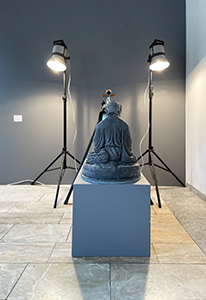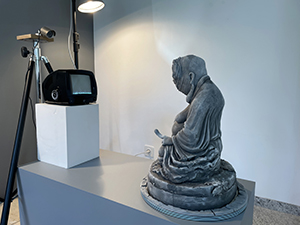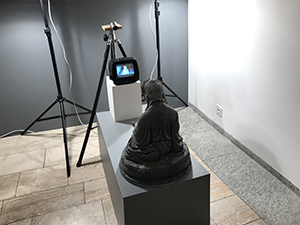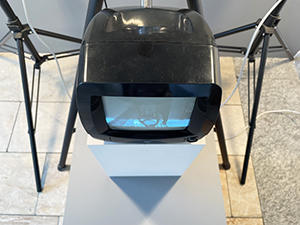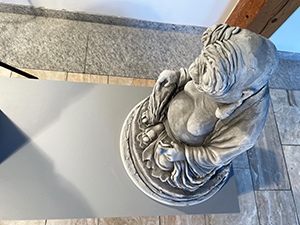
E.T.V Buddha
2021. Video sculpture: hand-built statue of unfired clay, TV monitor, closed-circuit camera, tripod, plinth, silent, dimensions variable. Dimensions variable. Installation and detail views at Go Green Art Gallery in Erlenbach in the summer exhibition, curated by Katerina Sedy.
Installation and detail views of E.T.V Buddha (2021) by Dimitrina Sevova, from the summer exhibition at Go Green Art Gallery in Erlenbach, Switzerland, curated by Katherina Sedy. Video sculpture: hand-built statue of unfired clay, TV monitor, closed-circuit camera, tripod, plinth, silent, dimensions variable. Photos courtesy of the artist
E.T.V Buddha
“If you meet the Buddha on the road, …”
E.T.V Buddha (2021) is a video sculpture in a dialog with TV Buddha (1974) by Nam Jun Paik, which combines an authentic 18th-century Buddha sculpture gazing at itself on the display of a monitor connected to a closed-circuit TV camera. It turned out to be one of Nam Jun Paik’s most popular artworks. Initially featuring the antique Buddha statue once purchased as an investment, Paik re-produced it in seriality in successive versions until 2002, with TV monitors of different shapes and ages and a range of appropriated Buddha figures signed by himself in Chinese and English. Paik later substituted these with more ambiguous statues hand-made by himself and cast in concrete or bronze, betraying Duchamp’s ready-made formula.
In E.T.V Buddha, as in TV Buddha, the stillness of the sculpture and its static image is played out in a loop, a silent contemplation monitored continuously on a television set. The supply-chain visual performance here and now sets up a correlational network between the mind and the object’s reality. It emphasizes the power of observation and the phenomenological space of perceptions. The closed-circuit video sculpture constitutes a correlational circle affirming the self, a display without any possible transcendence, caught in an endless loop in real time. Intentionality runs between its output and input, a kind of proto-algorithmic pattern fueled by technology and media performativity. There is an operative blindness in its seeing, with media and technology involved in the production of the self in the interplay of vanity and constant surveillance. As the media theorist Marshall McLuhan once stated, “it is the continuous embrace of our own technology in daily use that puts us in the Narcissus role of subliminal awareness and numbness in relation to these images of ourselves.”
E.T.V Buddha contains joyful and humorous elements in relation to the neo-avant-garde gestures to ask what a ready-made object is and how the appropriation of an idea can hijack (détourner) the entire logic of the artwork. E.T.V Buddha questions the notion of authenticity and the aura, applying historicity as a media archaeology to unearth certain patterns encoded in today’s technology. The found object is a vintage closed-circuit surveillance system, while the 18th century statue of Buddha is replaced by a sculpture newly made by the artist. Another reference appears, to E.T. the Extra-Terrestrial (1982; directed by Steven Spielberg), to evoke the direct transmission of feelings without the use of language or other encoding system. The meaning of the universe is not assigned by any signs. High intelligence is not necessarily intellectual-analytical in the universe and is not necessarily a human privilege. “Don’t think! Feel!,” says Bruce. “It’s like a finger pointing away to the moon. Don’t concentrate on the finger or you will miss all that heavenly glory.” (Enter the Dragon, 1973) The opening of alien perceptions is about emotional content, not an exhibition.
* For E.T.V Buddha I used the Happy Buddha. Perhaps it is not as still, but laughing.
